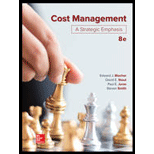
1.
State the difference between short term fixed costs and short term variable costs.
1.
Explanation of Solution
Difference between short term variable costs and short term fixed costs:
| Variable | Fixed |
| In short run, the variable cost will change according to one or more cost drivers. | In short run, the fixed costs are related to the level of capacity in which they are supplied. |
| Variable cost changes when the level of activity changes. | Fixed costs are related more to the level of production rather than level of activity. |
| These costs are incurred as and when needed. | These cost are incurred on time in a given period |
| Example: Salary based on piecework | Example: Engineering salaries |
Table (1)
For most of organizations today, the suitable support cost is short term fixed. There are few costs that are spent regardless of the demand; this will make way for a managerial challenge of how to manage the demand and supply on spending for support costs. With proper implementation of Activity Based Costing they show the management the amount of cost incurred.
2.
Describe the data that should be used to calculate the cost of handling a customer order.
2.
Explanation of Solution
The Activity based costing provides various options when implemented they are:
- In the calculation, the denominator used can either be actual activity or the budgeted activity.
- Another way is that, it combines both the cost of used capacity and also unused capacity in the cost allocation rate.
The most common support cost used is the fixed cost in the short run, when the denominator used is budgeted for the determination of activity based costing rate it will increase the cost allocation rate and decreases the level of activity. When these increase allocation rates are used for determining contract bids and product prices, the company will in turn increase the price for off-setting the increase in the allocation rate. This will result in lower demand and lower activity level and increase the cost rates for the level of activity. This will make a situation where there is no customer left to bear the fixed support cost. This effect is called depth-spiral effect.
To avoid this effect of depth-spiral, it is advised to use practical capacity as the denominator for calculation of activity based costing rates. It refers to the cost that will be incurred without creating any kind of delays or overtime in the production.
3.
Calculate the following for the support activity.
3.
Explanation of Solution
1) Calculate the support cost rate:
Therefore, the support cost rate is $72 per order handled.
2) Calculate the cost of unused capacity:
Therefore, the cost of unused capacity is $72,000.
3) Calculate the percentage capacity utilization:
Therefore, the percentage capacity utilization is 90% which is order handling of activity.
The management can take decisions to balance the demand and supply by monitoring the resources that are supplied and the cost incurrent in unused capacity.
The Company Z’s management is of strategic concern as the company is functioning on the basis of differentiating strategy. This makes the management of resources spending much more important. The value of the costs in dollars are high this provides worthy attention to it.
4.
Calculate the following after implementation of total quality management.
4.
Explanation of Solution
When the activity based costing rate is calculated on practical capacity, it could be used to increased efficiencies with implementation of total quality management initiative. Before the implementation of TQM, the cost was $72 per order but after the implementation it is $60 which means that the cost has dropped. But however the cost of unused capacity increases from $72,000 in 90% to $180,000 in 75% capacity utilization.
Working notes:
4) For prior to the implementation:
5) For after implementation:
6) For capacity utilization:
Prior period:
After implementation:
5.
Describe the strategies that are available to managers for reducing the unused capacity.
5.
Explanation of Solution
The company can take the following steps when faced with unused capacity:
- Reduce their spending on resources for support activities.
- Develop new means to utilize existing capacity that are presently not used
6.
Recommend to the management on how the cost of unused capacity must be assigned.
6.
Explanation of Solution
If the associated capacity were acquired specifically to serve a particular customer or market segment, it is considered logical to assign the given customer or the market segment.
In case the excess capacity came about due to any future expansion plan, the cost of unused capacity must be assigned to the division on priority.
The basic rule specified in this situation is that unused capacity must be costs must be traced back to the place in the organisation where the decision to acquire the associated capacity was made.
Want to see more full solutions like this?
Chapter 15 Solutions
Cost Management
- I am searching for the correct answer to this general accounting problem with proper accounting rules.arrow_forwardI am looking for help with this general accounting question using proper accounting standards.arrow_forwardCan you explain the correct approach to solve this general accounting question?arrow_forward

 AccountingAccountingISBN:9781337272094Author:WARREN, Carl S., Reeve, James M., Duchac, Jonathan E.Publisher:Cengage Learning,
AccountingAccountingISBN:9781337272094Author:WARREN, Carl S., Reeve, James M., Duchac, Jonathan E.Publisher:Cengage Learning, Accounting Information SystemsAccountingISBN:9781337619202Author:Hall, James A.Publisher:Cengage Learning,
Accounting Information SystemsAccountingISBN:9781337619202Author:Hall, James A.Publisher:Cengage Learning, Horngren's Cost Accounting: A Managerial Emphasis...AccountingISBN:9780134475585Author:Srikant M. Datar, Madhav V. RajanPublisher:PEARSON
Horngren's Cost Accounting: A Managerial Emphasis...AccountingISBN:9780134475585Author:Srikant M. Datar, Madhav V. RajanPublisher:PEARSON Intermediate AccountingAccountingISBN:9781259722660Author:J. David Spiceland, Mark W. Nelson, Wayne M ThomasPublisher:McGraw-Hill Education
Intermediate AccountingAccountingISBN:9781259722660Author:J. David Spiceland, Mark W. Nelson, Wayne M ThomasPublisher:McGraw-Hill Education Financial and Managerial AccountingAccountingISBN:9781259726705Author:John J Wild, Ken W. Shaw, Barbara Chiappetta Fundamental Accounting PrinciplesPublisher:McGraw-Hill Education
Financial and Managerial AccountingAccountingISBN:9781259726705Author:John J Wild, Ken W. Shaw, Barbara Chiappetta Fundamental Accounting PrinciplesPublisher:McGraw-Hill Education





